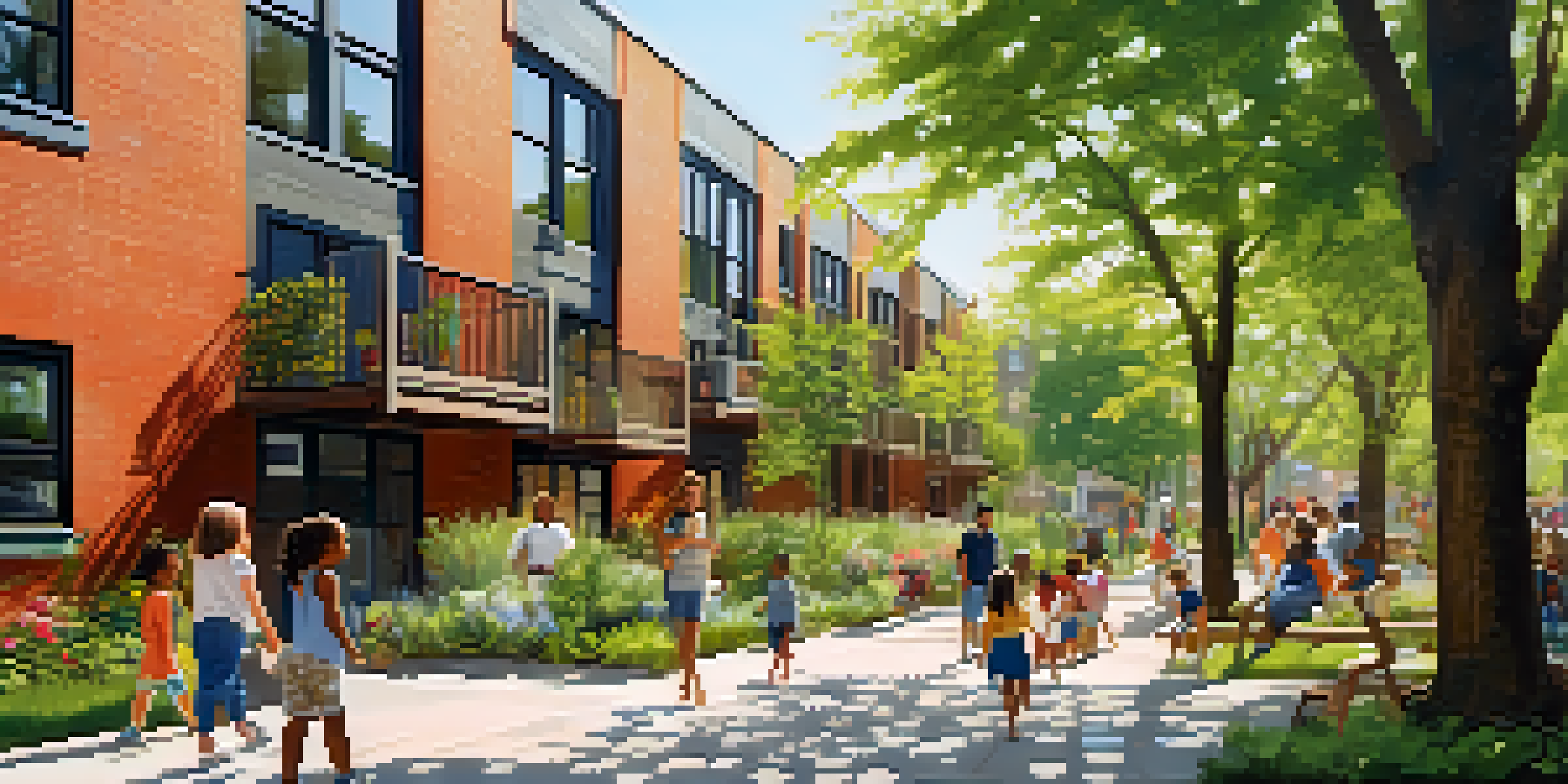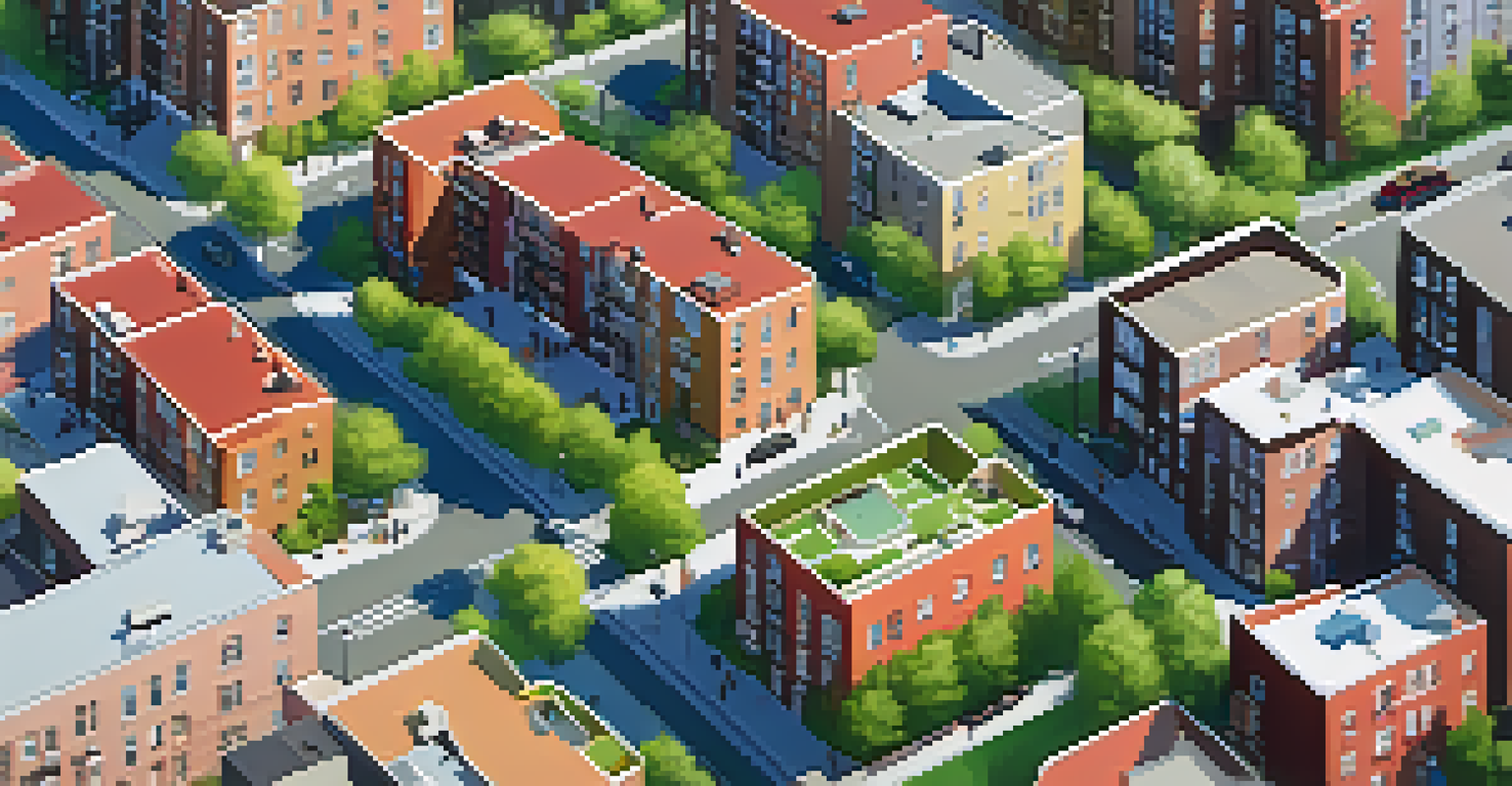Mixed-Income Housing: A Solution for NYC's Urban Challenges

Understanding Mixed-Income Housing and Its Importance
Mixed-income housing refers to residential developments that include units for residents of varying income levels. This approach not only promotes socioeconomic diversity but also fosters community engagement and cohesion. In the context of New York City, where income disparity is stark, mixed-income housing stands out as a promising solution to create inclusive neighborhoods.
Diversity is not a reason for division, but a reason for unity and understanding.
By blending higher and lower-income households, these developments help to break down the socioeconomic barriers that often segregate communities. This integration can lead to improved access to resources, better schools, and a stronger local economy. Ultimately, mixed-income housing creates environments where people from different backgrounds can learn from and support each other.
Moreover, mixed-income housing can help combat the stigma often associated with low-income housing. By designing aesthetically appealing and well-maintained buildings that accommodate various income levels, cities like NYC can foster a sense of pride and ownership among residents, leading to more stable and vibrant communities.
The Current Housing Crisis in New York City
New York City is grappling with a significant housing crisis, characterized by skyrocketing rents and a shortage of affordable units. Many residents struggle to find homes that fit their budgets, leading to overcrowding and displacement. The pressures of high demand and limited supply have made it increasingly difficult for lower and middle-income families to secure stable housing.

In addition, the city's housing landscape is often marked by stark inequalities, with wealthier neighborhoods enjoying better amenities and services. This disparity creates a cycle of poverty and isolation for those in low-income areas, further entrenching socioeconomic divides. The need for solutions that bridge these gaps has never been more urgent.
Mixed-Income Housing Promotes Diversity
Integrating residents from various income levels fosters community engagement and reduces socioeconomic barriers.
Mixed-income housing presents a tangible way to address these challenges. By providing a spectrum of housing options in a single development, it can help alleviate the pressure on the housing market while also improving the overall quality of life for all residents. Such initiatives can lead to healthier, more balanced communities that benefit everyone.
Benefits of Mixed-Income Housing for Communities
One of the most significant benefits of mixed-income housing is its potential to foster diversity and inclusion. When people from different economic backgrounds live in close proximity, it encourages interaction and understanding, which can break down stereotypes and build empathy. This social cohesion is crucial in urban settings like NYC, where diversity is one of the city’s greatest strengths.
The best way to predict the future is to create it.
Additionally, mixed-income developments often lead to improved public infrastructure and services. With a more diverse tax base, local governments have the resources to invest in schools, parks, and public transportation. This investment not only enhances the quality of life for residents but also attracts new businesses and fosters economic growth.
Furthermore, these communities tend to have lower crime rates compared to areas with concentrated poverty. Research indicates that when individuals from varying socioeconomic backgrounds coexist, they can create a safer environment through mutual accountability and support. Ultimately, mixed-income housing can transform neighborhoods into thriving, resilient communities.
Challenges in Implementing Mixed-Income Housing
While mixed-income housing offers numerous benefits, implementing such projects is not without its challenges. One significant hurdle is the availability of suitable land in densely populated areas like NYC. Developers often face zoning restrictions and high costs, which can limit their ability to create mixed-income communities.
Moreover, there can be resistance from existing communities, often referred to as 'NIMBYism' (Not In My Backyard). Some residents may fear that mixed-income housing could alter the character of their neighborhood or lead to increased traffic and congestion. Addressing these concerns requires effective communication and outreach to demonstrate the long-term benefits of mixed-income developments.
Addressing NYC's Housing Crisis
Mixed-income housing provides a spectrum of affordable options, alleviating pressure on the housing market in New York City.
Finally, ensuring that these projects remain affordable over time is crucial. Without proper policies and protections, there's a risk that mixed-income developments could eventually become gentrified, displacing the very residents they were meant to support. It’s essential for city planners and developers to work together to create and maintain affordable housing solutions.
Successful Examples of Mixed-Income Housing in NYC
New York City has seen several successful mixed-income housing developments that serve as models for future projects. For example, the Via Verde development in the South Bronx integrates affordable, market-rate, and subsidized units within an eco-friendly framework. This project not only provides much-needed housing but also promotes sustainability and community health.
Another example is the Atlantic Yards project in Brooklyn, which includes a mix of affordable and market-rate apartments. This development has transformed the area while ensuring that a significant portion of the housing remains accessible to lower-income families. Such projects illustrate how mixed-income housing can revitalize neighborhoods and promote diversity.
These success stories highlight the potential for mixed-income housing to address urban challenges in NYC. By learning from these examples, city planners and developers can create more inclusive and sustainable communities that meet the diverse needs of New Yorkers.
The Role of Government in Supporting Mixed-Income Housing
Government plays a crucial role in promoting mixed-income housing through policy and funding. By offering incentives to developers, such as tax breaks or zoning allowances, cities can encourage the construction of mixed-income projects. Such initiatives can help alleviate the housing crisis while promoting socioeconomic diversity.
Moreover, public-private partnerships can be instrumental in financing mixed-income developments. Collaborations between government entities and private developers can pool resources and expertise, resulting in more effective and sustainable housing solutions. This approach can also help mitigate some of the financial risks associated with large-scale developments.
Government's Role is Crucial
Effective policies and partnerships can support the development of mixed-income housing, ensuring long-term affordability and inclusivity.
Additionally, government policies must prioritize the preservation of affordability in mixed-income housing. Implementing measures such as rent stabilization and inclusionary zoning can help ensure that these projects remain accessible to low and middle-income families over time. Through these efforts, the government can help foster equitable growth and opportunity in urban areas.
Looking Ahead: The Future of Mixed-Income Housing in NYC
As New York City continues to grapple with its housing crisis, mixed-income housing will likely play an increasingly vital role in shaping the urban landscape. The need for affordable housing is more pressing than ever, and this model offers a viable solution that promotes inclusivity and community development. With the right policies and support, mixed-income projects can significantly impact the city’s future.
Moreover, the growing trend of remote work and changing urban preferences may influence how mixed-income housing is designed and implemented. Developers may incorporate more flexible living spaces and amenities that cater to a diverse range of residents, making these communities even more attractive. This adaptability can help address the evolving needs of city dwellers.

Ultimately, the future of mixed-income housing in NYC rests on collaboration between government, developers, and the community. By working together, they can create resilient neighborhoods that not only provide affordable housing but also empower residents and foster a sense of belonging. It’s a promising path forward for a more equitable and vibrant New York City.